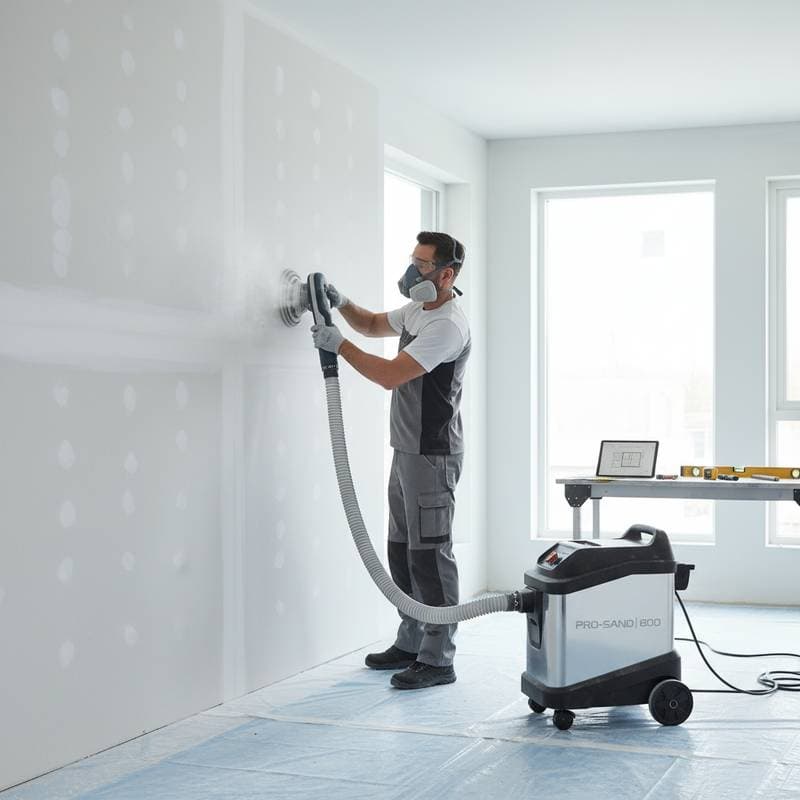Avoid the $800 DIY Sanding Blunder That Ruins Your Walls
Homeowners often envision a room refreshed with new paint. Enthusiasm grows as color choices are tested and supplies are gathered. Sanding emerges as a seemingly straightforward task, yet improper execution frequently results in $800 worth of repairs. Walls end up uneven, scratched, or severely compromised, demanding professional intervention after hours of effort and materials are squandered.
Knowledge of common sanding pitfalls empowers individuals to bypass these expenses and aggravations. Through meticulous preparation, suitable equipment, and refined methods, a smooth, expert-level surface becomes attainable. This foundation promotes superior paint adhesion and longevity.
Root Causes of the $800 Sanding Blunder
Over-sanding or irregular sanding stands as the primary trigger for substantial wall harm. Amateur painters frequently apply excessive force, select inappropriate grit levels, or employ erratic strokes. Sanding aims to establish an even base for primer and paint adhesion, not to erode the drywall paper or thin the joint compound. When these elements fray or diminish, restoration expenses escalate rapidly.
Expenses Associated with Sanding Repairs
Hiring experts for drywall corrections stemming from sanding flaws generally costs between $300 and $800, influenced by the affected area's extent and intensity. Basic patching and re-sanding for superficial issues may range from $150 to $300. More involved processes, such as re-skimming, priming, and repainting larger sections, surpass $800. Labor constitutes a significant portion, as matching texture and finish demands precision and duration.
| Repair Type | Typical Range | Includes |
|---|---|---|
| Light surface patching | $150 - $300 | Spot filling, light sanding, touch-up paint |
| Moderate damage repair | $400 - $600 | Re-skimming, sanding, priming, repainting |
| Full wall resurfacing | $700 - $800+ | Complete drywall skim coat, primer, full repaint |
Key Elements Contributing to Expensive Sanding Damage
Multiple aspects determine the degree of harm from sanding and the subsequent repair outlay.
-
Grit Selection: Opting for overly coarse sandpaper risks gouging the wall. A medium grit of 120 to 150 suffices for most drywall tasks. Finer options preserve material while smoothing effectively; coarser varieties excavate dips visible beneath paint layers.
-
Uneven Pressure: Inconsistent force during sanding produces undulating patterns. These irregularities glare under angled lighting post-painting. Correction then requires targeted patching and additional smoothing.
-
Inadequate Dust Removal: Residual sanding particles embedded under primer or paint yield textured, imperfect outcomes. Wipe surfaces with a microfiber cloth or employ a vacuum attachment immediately after sanding to eliminate contaminants.
-
Skipping Primer: Direct paint application over sanded zones leads to inconsistent absorption, manifesting as splotchy hues and uneven sheen. Apply a high-quality primer to seal pores and promote uniform coverage.
-
Moisture Complications: Sanding moist joint compound weakens the substrate, inviting future delamination. Permit full drying, typically 24 hours or more, before proceeding.
Mastering Correct Wall Sanding Techniques
Effective sanding prioritizes precision over haste. Equip a pole sander or hand sander with grit-appropriate paper. Employ gentle, circular movements with uniform pressure, concentrating on feathering joints and leveling patches without abrading the underlying structure.
Incorporate a vacuum-equipped sander or dust-free system to minimize airborne particles and simplify post-work cleanup. Post-sanding, examine walls under intense illumination to identify flaws. Address any depressions or marks with filler prior to priming.
Pricing for Expert Sanding and Prep Services
Engaging professionals for surface readying charges $1.50 to $3.50 per square foot, encompassing patching, sanding, and priming. In a typical room, this totals $200 to $500, varying by existing condition and dimensions. Although self-handling appeals to many, professional involvement yields enduring, impeccable outcomes.
| Service | Cost Range per Sq. Ft. | What It Includes |
|---|---|---|
| DIY sanding materials | $0.20 - $0.50 | Sandpaper, sponges, dust masks |
| Professional wall prep | $1.50 - $3.50 | Patching, sanding, priming |
| Full paint-ready finish | $3.00 - $5.00 | Complete preparation and cleanup |
Enduring Benefits of Thorough Surface Prep
Walls sanded and primed correctly enhance paint bonding, minimize revisions, and prolong finish durability. Initial outlays for expert prep, though notable, avert premature failures like flaking or bubbling that necessitate early repaints.
Subpar sanding diminishes even premium paints' aesthetic appeal. Illuminated imperfections highlight every flaw, potentially lowering property value during sales or leases. Invested effort in preparation elevates overall room quality and satisfaction.
Strategic Budgeting for Surface Preparation
For DIY approaches, allocate funds for essentials like sanding sponges, extension poles, dust sheeting, and primer. A basic kit runs $30 to $75; advanced dustless tools approach $150 to $300. Factor in a 10 to 15 percent buffer for unforeseen needs, such as additional filler for over-sanded spots.
When selecting pros, solicit itemized bids delineating prep, supplies, and application phases. Obtain quotes from several sources and inquire about their inspection and remediation protocols. Upfront dialogue curbs surprise charges and aligns expectations.
Essential Queries on Sanding and Painting
When to Schedule Drywall Sanding and Painting
Interior work suits any season, yet stable, low-humidity environments facilitate even curing and dust control. Off-peak timing often reduces rates due to lighter workloads.
What Grit Sandpaper Works Best for Drywall
Begin with 120-grit for initial smoothing of joints and patches, then progress to 220-grit for final feathering. This sequence prevents over-removal while achieving a paint-ready texture.
How to Prevent Dust During Sanding
Use a shop vacuum connected to your sander and seal vents with plastic sheeting. Wet sanding with a damp sponge suits small areas, though dry methods with extraction remain preferable for efficiency.



